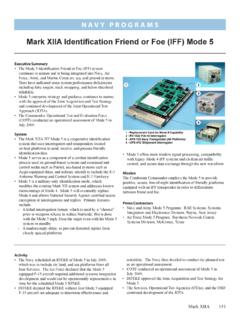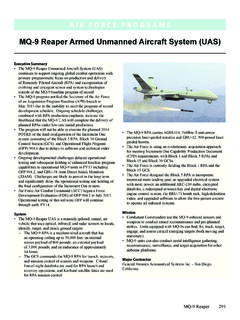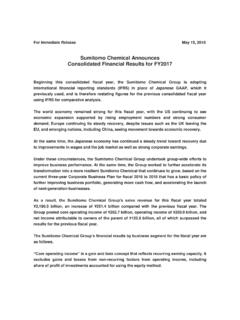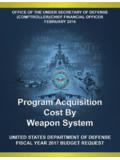Transcription of F-35 Joint Strike Fighter (JSF) - DOT&E
1 FY17 DOD PROGRAMSF-35 Joint Strike Fighter (JSF)Document (ORD), capabilities the F-35 needs in combat against current threats. Static structural and durability testing continued in CY17 for the third lifetime of the F-35A and F-35C test articles (one lifetime is 8,000 equivalent flight hours). F-35A testing completed in October 2017 and F-35C testing at the end of CY18. The JPO suspended durability testing for the F-35B after completion of the second lifetime of testing in February 2017; the test article had so many repairs it was no longer representative of the production aircraft.
2 The program has not yet procured another durability test article for the F-35B to begin the third lifetime of testing. The effect of the failures observed and repairs required during the first two lifetimes of testing on the service life certification of the F-35B aircraft is still to be determined. The service life for all three variants is planned to be 8,000 hours, however the F-35B service life may be less than that, even with extensive modifications to strengthen the aircraft already produced. Mission Data Load Development and Testing The Reprogramming Laboratory (USRL) continues to operate with cumbersome software tools and outdated or incomplete hardware.
3 The lab began creating Block 3F mission data files (MDFs) in the summer of 2017, and it will take 12 to 15 months to deliver a fully-verified mission data load (MDL), made up of a compilation of MDFs, for IOT&E. Installation of improved radio frequency signal generators within the USRL test lines, necessary to partially address shortfalls in the replication of realistic signals, was delayed until the JPO placed Lockheed Martin on contract in November 2017. Executive SummaryTest Strategy, Planning, and Activity The F-35 Joint Strike Fighter (JSF) program focused on completing developmental testing (DT) and verifying compliance with JSF contract specifications by the end of CY17.
4 The program completed two reviews of the DT work remaining and deleted test points in an attempt to stay on schedule. Some test points were considered to be in excess, but others were deemed important for DT or OT. Despite the test point deletions, continued test delays, particularly for mission systems and F-35B flight sciences, will likely push the end of DT into the first or second quarter of CY18, even as time and funding are running out for System Development and Demonstration (SDD). Preparations for IOT&E are progressing, although the program will not meet several of the readiness criteria until late CY18; as a result, formal entry into IOT&E will not occur before then.
5 The F-35 Joint Program Office (JPO) plans to transition into the next phase of development Continuous Capability Development and Delivery (C2D2) beginning in CY18, to address deficiencies identified in Block 3F development and to incrementally provide planned Block 4 capabilities. However, the original C2D2 schedule was not executable due to inadequate test resources in the timelines allocated for both developmental and operational testing to field the planned new capabilities. The program's C2D2 acquisition strategy and development and delivery timelines were under review at the time of this SDDD evelopmental Testing Flight sciences testing for all variants continued into CY17.
6 -F-35A testing completed in March 2017, with the exception of drag chute testing a Norway-unique test requirement. -F-35B testing continued throughout CY17 and will not be complete until early CY18. The need for test-unique tail coatings to prevent overheating the horizontal tails at high airspeed test points, repairing unanticipated cracks in the main landing gear and structural frame, and engine restrictions prohibiting some flight operations resulted in delays to testing. -F-35C work included testing of the redesigned outboard wing structure, required to support carriage of the AIM-9X air-to-air missile on a pylon.
7 Block 3F mission systems testing continued throughout CY17. DOT&E estimates mission systems testing will continue through February 2018. The program will not be able to completely mitigate the many open deficiencies by the end of SDD, resulting in shortfalls in fielded Block 3F capabilities identified in the JSF Operational Requirements JSF 31FY17 DOD PROGRAMS32 JSF -The lab test lines need a number of key hardware upgrades to effectively and efficiently develop Block 3F MDFs, and to test and verify their signal detection, identification, and geolocation performance in scenarios representative of combat against the advanced adversaries for which the F-35 was designed.
8 -The Department programmed $45 Million in FY14-15 for upgrades, but the JPO failed to initiate the contract actions. -The USRL procured 16 new radio frequency signal generator systems known as Advanced Pulse Generators (APGs) 8 for each of 2 reprogramming test lines which will overcome the lab s signal fidelity shortfalls, but still will not provide enough signal density. -The USRL plans to complete installation and checkout of the APGs, and the new computer hardware that controls them, in the fall of CY18. The installation was delayed until the JPO put Lockheed Martin on contract in November 2017 to conduct the security certification, accreditation, and configuration management processes necessary to obtain authorization to operate in the new configuration.
9 This process is expected to take a year to complete. -Even after the installation and certification of the new configuration, the lab will still lack a sufficient number of signal generators to simulate a realistic, dense threat laydown with the multiple modern surface-to-air missiles, combat aircraft, and many supporting air defense radars that make up such a laydown. Substantial additional investments that have yet to be fully planned or funded are required as soon as possible to upgrade the USRL in order to support F-35 C2D2 MDL development. -The C2D2 plan includes new Technical Refresh 3 processors and other new hardware.
10 -Concurrent F-35 development and production has resulted in multiple fielded F-35 configurations, many of which will remain active during the C2D2 phase. The USRL, or an additional reprogramming lab, will need to have the capability to simultaneously create and test MDLs for existing and future avionics hardware and software Integration and Demonstration Events The JPO completed planned Block 3F Weapons Delivery Accuracy events in CY17 for bombs and missiles, with 15 of 27 results still in analysis. These events have continued to be a source of discovery of deficiencies, and frequently paused progress until corrections could be developed and tested.















